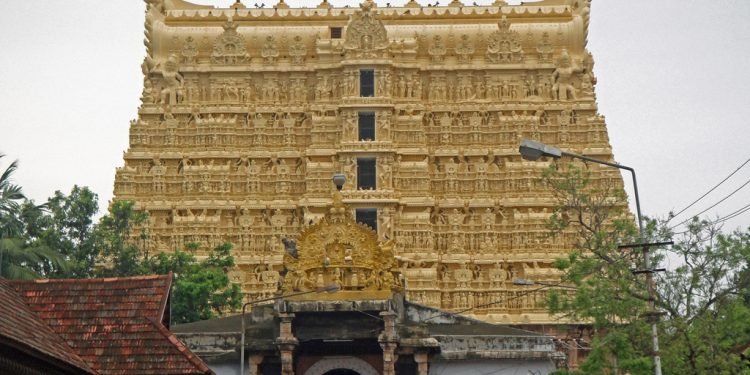Temple of Sree Padmanabhaswamy is lost in antiquity. It is not possible to determine with any exactitude, from any reliable historical documents or other sources as to when and by whom the original idol of Sree Padmanabhaswamy was consecrated. The Temple has references in Epics and Puranas.
Shrine’s History
Several extant Hindu Texts like the Brahma Purana, Matsya Purana, Varaha Purana, Skanda Purana, Padma Purana, Vayu Purana, Bhagavata Purana and the Mahabharata mention this shrine. The Temple has been referred to in the Sangam Period of literature between 500 B.C and 300 A.D several times. Many conventional historians and scholars are of the opinion that one of the names that the Temple had – “The Golden Temple” – literally was in cognizance of the fact that the Temple was already unimaginably wealthy by that point. Many extant pieces of Sangam Tamil literature and poetry, and even the later works of Ninth Century poet-saints like Nammalwar, refer to the Temple and even the city as having walls of pure gold. At some places, both the Temple and the entire city are often eulogized even as being made of gold, and the Temple of Heaven.
The temple is one of the 108 principal Divya Desams in Vaishnavism, and is glorified in the Divya Prabandha,. The Divya Prabandha glorifies this shrine as being among the 13 Divya Desam in Malai Nadu . The 8th century Alvar Nammalvar sang the glories of Padmanabha. The Ananthapuram Temple in Kasargod is believed to be the ‘Moolasthanam’ of the Temple. The sage Vilvamangalathu Swamiyar, who resided near Ananthapuram Temple in Kasargod District, prayed to Lord Vishnu for his darshan or “auspicious sight”. The Lord is believed to have come in the guise of a little boy who was mischievous. The boy defiled the Idol which was kept for Puja. The sage became enraged at this and chased away the boy, who disappeared. After a long search, when he was walking on the banks of Arabian Sea, he heard a pulaya lady threatening her child that she would throw him in Ananthankadu.
The moment the Swami heard the word Ananthankadu he was delighted. He proceeded to Ananthankadu based on the directions of the lady of whom he enquired. The Sage reached Ananthankadu searching for the boy. There he saw the boy merging into an Iluppa tree . The tree fell down and became Anantha Sayana Moorti. But the edifice that the Lord assumed was of an extraordinarily large size, with His head at Thiruvallom, navel at Thiruvananthapuram, and lotus-feet at Thrippadapuram, making him some eight miles in length. The Sage requested the Lord to shrink to a smaller proportion that would be thrice the length of his staff. Immediately the Lord shrank to the form of the Idol that is seen at present in the Temple. But even then many Iluppa trees obstructed a complete vision of the Lord.
The Sage saw the Lord in three parts ? thirumukham, thiruvudal and thrippadam. Swami prayed to Padmanabha to be forgiven. The Swami offered Rice Kanji and Uppumanga in a coconut shell to the Perumal which he obtained from the pulaya woman. The spot where the Sage had darsan of the Lord belonged to Koopakkara Potti and Karuva Potti. With the assistance of the reigning King and some Brahmin households a Temple was constructed. Koopakkara Potti was made the Tantri of the Temple. The Ananthankadu Nagaraja Temple still exists to the north west of the Padmanabhaswamy Temple. The Samadhi of the Swamiyar exists to the west of the Padmanabha Temple. A Krishna Temple was built over the Samadhi. This Temple, known as Vilvamangalam Sri Krishna Swami Temple, belongs to Thrissur Naduvil Madhom.
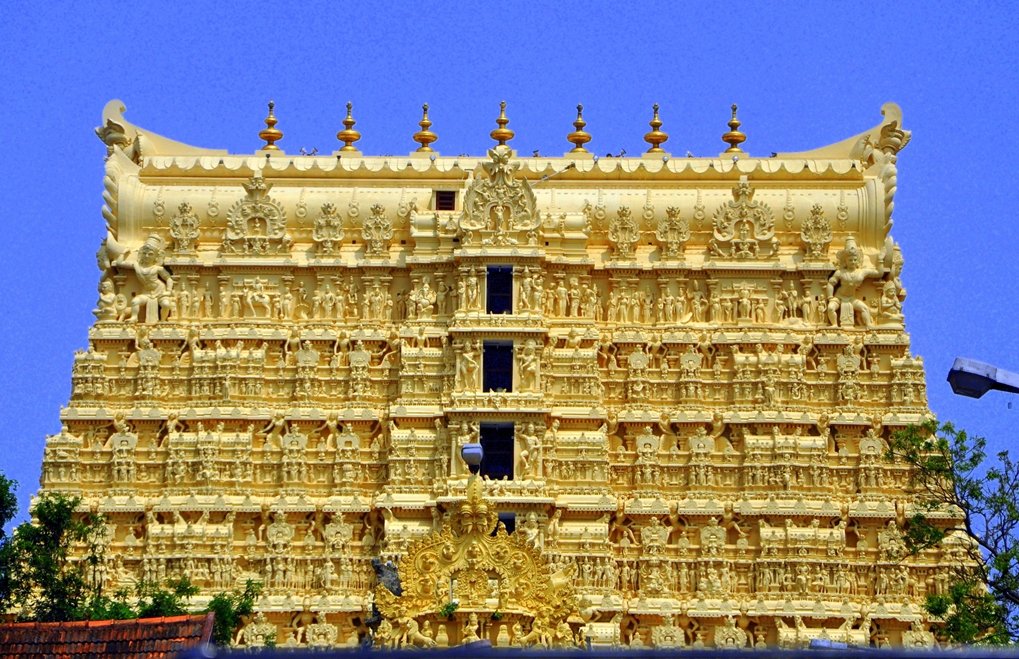
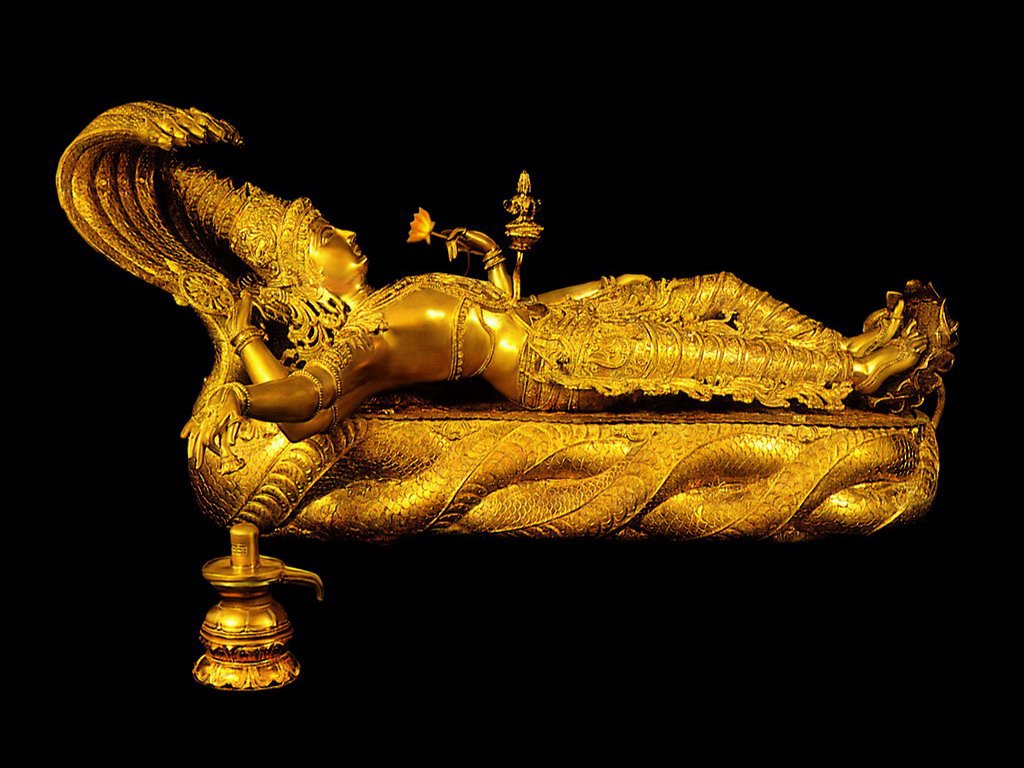
Architectural Relevance of This Shrine
The main shrine In the sanctum sanctorum, Padmanabha reclines on the serpent Anantha or Adi Sesha. The serpent has five hoods facing inwards, signifying contemplation. The Lord’s right hand is placed over a Shiva lingam. Sridevi-Lakshmi, the Goddess of Prosperity and Bhudevi the Goddess of Earth, two consorts of Vishnu are by his side. Brahma emerges on a lotus, which emanates from the navel of the Lord. The deity is made from 12,000 saligramams. These saligrams are from the banks of the Gandaki River in Nepal, and to commemorate this certain ritual used to be performed at the Pashupatinath Temple. The deity of Padmanabha is covered with, “Katusarkara yogam”, a special ayurvedic mix, which forms a plaster that keeps the deity clean. The daily worship is with flowers and for the abhisheka, special deities are used. The platforms in front of the vimanam and where the deity rests, are both carved out of a single massive stone and hence called “Ottakkal-mandapam.” On the orders of Marthanda Varma , the Ottakkal-mandapam was cut out of a rock at Thirumala, about 4 miles north of the temple. It measured 20 square feet by 2.5 feet thick and was placed in front of the deity in the month of Edavom 906 M.E.
At the same time, Marthanda Varma also brought 12,000 shaligrams, aniconic representations of Vishnu, from the Gandaki River, north of Benares to the temple. These were used in the reconsecration of the Padmanabha. In order to perform darshan and puja, one has to ascend to the mandapam. The Deity is visible through three doors ? the visage of the reclining Lord and Siva Linga underneath the hand is seen through the first door; Sridevi and Bhrigu Muni in Katusarkara, Brahma seated on a lotus emanating from the Lord’s navel, hence the name, “Padmanabha”, gold abhisheka moorthies of Lord Padmanabha, Sridevi and Bhudevi, and silver utsava moorthi of Padmanabha through the second door; the Lord’s feet, and Bhudevi and Markandeya Muni in Katusarkara through the third door. Only the King of Travancore may perform sashtanga namaskaram, or prostrate on the “Ottakkal Mandapam”. It is traditionally held that anybody who prostrates on the mandapam has surrendered all that he possesses to the Deity. Since the rule has already done that, he is permitted to prostrate on this mandapam.
Gopuram of the Padmanabhaswamy Temple Other shrines Inside the Temple, there are two other important shrines, Thekkedom and Thiruvambadi, for the Deities, Ugra Narasimha and Krishna Swami respectively. Thiruvambadi shrine enjoys an independent status and predates the shrine of Padmanabha.
Thiruvambadi shrine has its own namaskar mandapam, Bali stones and flag mast. The Lord of Thiruvambadi is Parthasarathi, the Divine Charioteer of Arjuna. The granite idol of the Lord of Thiruvambadi was brought from Gujarat by seventy-two families of Vrishni Vamsa Kshatriyas. As these Vrishnies belong to the lineage of Lord Krishna, they are known as Krishnan vakakkar. The two-armed granite idol, with one hand holding the whip and the other resting on the left thigh holding the conch close to it, is in standing posture. On Ekadasi days the Lord is dressed and decorated as Mohini. There are also shrines for Rama accompanied by Sita, Lakshmana and Hanuman, Vishwaksena , Vyasa, Ganapati, Sasta and Kshetrapala. Grand idols of Garuda and Hanuman stand with folded hands in the Valiya balikkal area. The thevara idols of Chithira Thirunal Balarama Varma and Uthradom Thirunal Marthanda Varma are housed in the south-east part of the Temple.
Gopuram The foundation of the present gopuram was laid in 1566. The temple has a 100-foot, seven-tier gopuram made in the Pandyan style. The temple stands by the side of a tank, named Padma Theertham . The temple has a corridor with 365 and one-quarter sculptured granite-stone pillars with elaborate carvings which stand out to be an ultimate testimonial for the Vishwakarma sthapathis in sculpting this architectural masterpiece. This corridor extends from the eastern side into the sanctum sanctorum. An eighty-foot flag-staff stands in front of the main entry from the prakaram. The ground floor under the gopuram is known as the ‘Nataka Sala’ where the famous temple art Kathakali was staged in the night during the ten-day uthsavam conducted twice a year, during the Malayalam months of Meenam and Thulam.
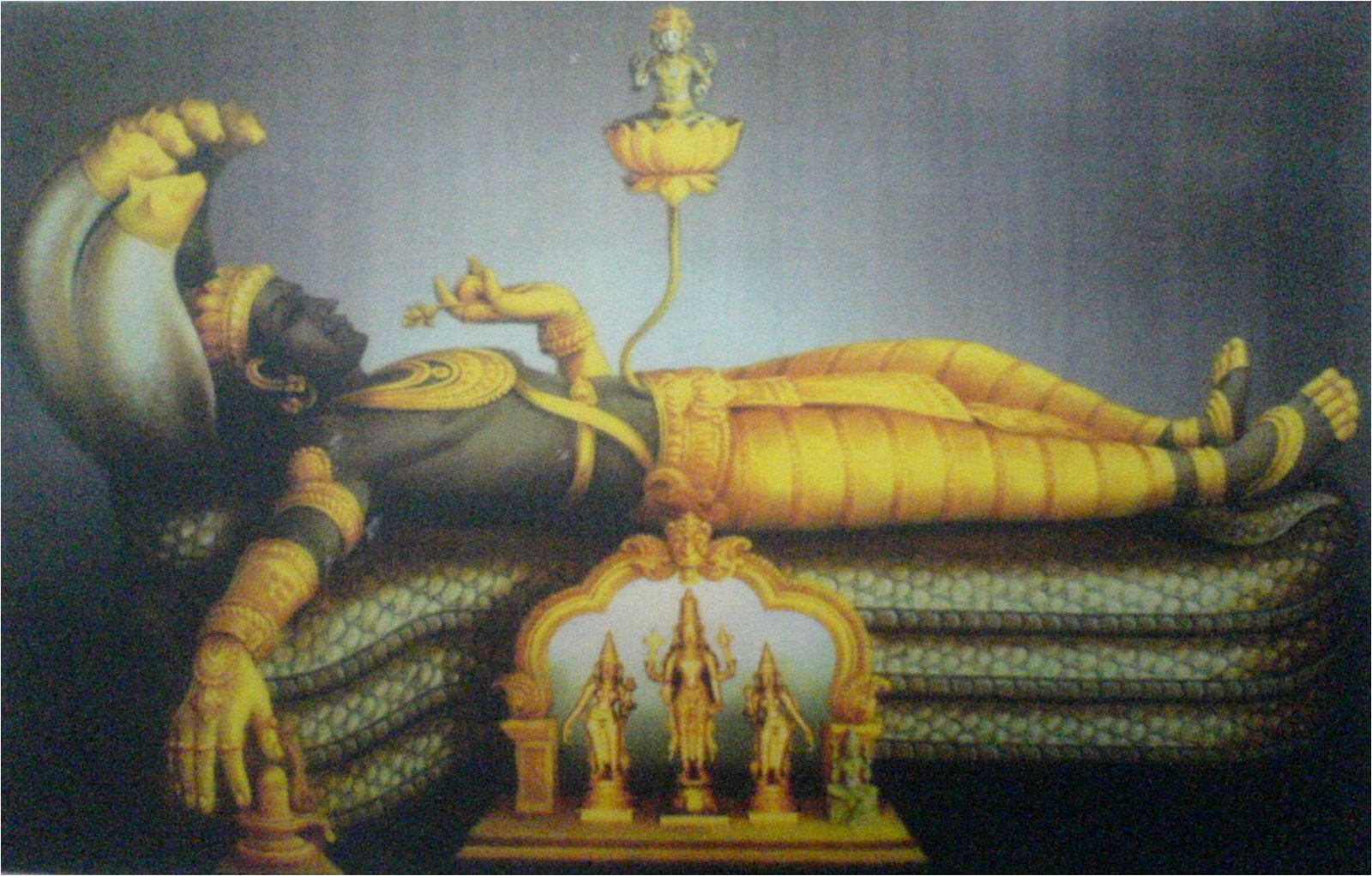
Shrine’s Map Location and How to Go There
By Road
The nearest bus stop is Thiruvananthapuram
By Rail
The nearest railway station Thiruvananthapuram Central, about 1 km away
By Air
Nearest airport: Trivandrum International Airport, about 6 km away
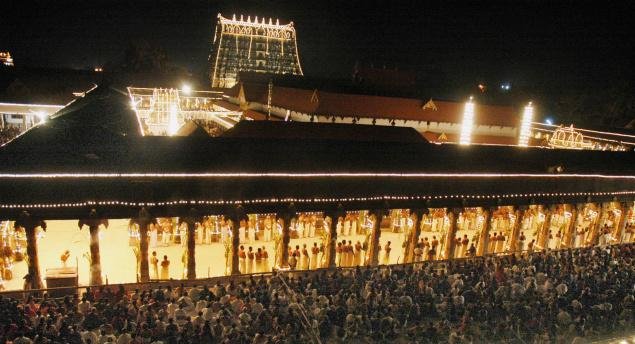
Shrine Timings
Morning 03.30 am to 04.45 am 06.30 am to 07.00 am 08.30 am to 10.00 am 10.30 am to 11.10 am 11.45 am to 12.00 Noon Evening 05.00 pm to 06.15 pm 06.45 pm to 07.20 pm
The above-indicated time schedule is subject to changes during festivals and other special occasions. During the festival occasions, the darshan time is reduced in order to perform the special poojas
Events Celebrated at This Shrine
Navaratri festival The Alpashy festival which is in October/November and the Panguni festival which is in Tamil month Panguni, March/April, lasts for 10 days each.
Extra Information About this Shrine
The best time to visit this temple is October/November during the Alpashy festival and March/April during Panguni festival.





































